Life for farmers in agricultural parts of British Columbia can be hard. Winters are long, the weather is unpredictable, and a couple of bad years can put even prepared families at risk of losing their livelihoods. Getting through these challenging periods is easier when farmers can diversify their income with activities like small-scale retail and housing rentals. Unfortunately, the provincial government seems to be moving in the other direction.
The cornerstone of B.C.’s efforts to regulate agricultural land use has been the Agricultural Land Reserve (ALR). Established by the provincial government when it passed the Agricultural Land Act in 1973, the ALR restricts development on land located at town and city peripheries that’s considered suitable for farming, in order to protect those areas from the negative effects of larger developments and commercial projects. It includes approximately 4.7 million hectares of land in B.C., representing only about 5 percent of B.C.’s total land base.
